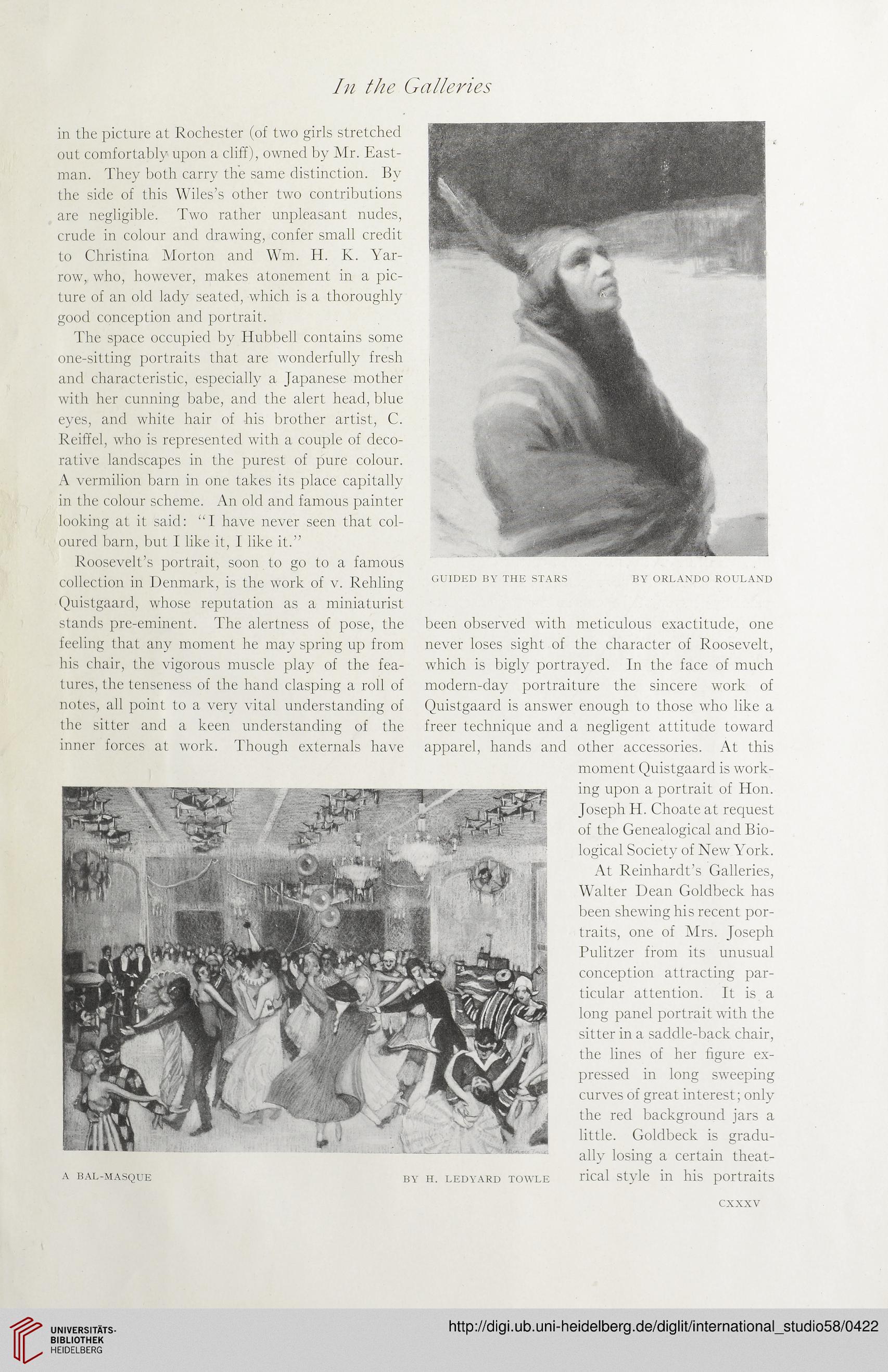In the Galleries
in the picture at Rochester (of two girls stretched
out comfortably upon a cliff), owned by Mr. East-
man. They both carry the same distinction. By
the side of this Wiles’s other two contributions
are negligible. Two rather unpleasant nudes,
crude in colour and drawing, confer small credit
to Christina Morton and Wm. H. K. Yar-
row, who, however, makes atonement in a pic-
ture of an old lady seated, which is a thoroughly
good conception and portrait.
The space occupied by Hubbell contains some
one-sitting portraits that are wonderfully fresh
and characteristic, especially a Japanese mother
with her cunning babe, and the alert head, blue
eyes, and white hair of his brother artist, C.
Reiffel, who is represented with a couple of deco-
rative landscapes in the purest of pure colour.
A vermilion barn in one takes its place capitally
in the colour scheme. An old and famous painter
looking at it said: “I have never seen that col-
oured barn, but I like it, I like it.”
Roosevelt’s portrait, soon to go to a famous
collection in Denmark, is the work of v. Rehling
Quistgaard, whose reputation as a miniaturist
stands pre-eminent. The alertness of pose, the
feeling that any moment he may spring up from
his chair, the vigorous muscle play of the fea-
tures, the tenseness of the hand clasping a roll of
notes, all point to a very vital understanding of
the sitter and a keen understanding of the
inner forces at work. Though externals have
GUIDED BY THE STARS BY ORLANDO ROULAND
been observed with meticulous exactitude, one
never loses sight of the character of Roosevelt,
which is bigly portrayed. In the face of much
modern-day portraiture the sincere work of
Quistgaard is answer enough to those who like a
freer technique and a negligent attitude toward
apparel, hands and other accessories. At this
A BAL-MASQUE
BY H. LEDYARD TOWLE
moment Quistgaard is work-
ing upon a portrait of Hon.
Joseph H. Choate at request
of the Genealogical and Bio-
logical Society of New York.
At Reinhardt’s Galleries,
Walter Dean Goldbeck has
been shewing his recent por-
traits, one of Mrs. Joseph
Pulitzer from its unusual
conception attracting par-
ticular attention. It is a
long panel portrait with the
sitter in a saddle-back chair,
the lines of her figure ex-
pressed in long sweeping
curves of great interest; only
the red background jars a
little. Goldbeck is gradu-
ally losing a certain theat-
rical style in his portraits
cxxxv
in the picture at Rochester (of two girls stretched
out comfortably upon a cliff), owned by Mr. East-
man. They both carry the same distinction. By
the side of this Wiles’s other two contributions
are negligible. Two rather unpleasant nudes,
crude in colour and drawing, confer small credit
to Christina Morton and Wm. H. K. Yar-
row, who, however, makes atonement in a pic-
ture of an old lady seated, which is a thoroughly
good conception and portrait.
The space occupied by Hubbell contains some
one-sitting portraits that are wonderfully fresh
and characteristic, especially a Japanese mother
with her cunning babe, and the alert head, blue
eyes, and white hair of his brother artist, C.
Reiffel, who is represented with a couple of deco-
rative landscapes in the purest of pure colour.
A vermilion barn in one takes its place capitally
in the colour scheme. An old and famous painter
looking at it said: “I have never seen that col-
oured barn, but I like it, I like it.”
Roosevelt’s portrait, soon to go to a famous
collection in Denmark, is the work of v. Rehling
Quistgaard, whose reputation as a miniaturist
stands pre-eminent. The alertness of pose, the
feeling that any moment he may spring up from
his chair, the vigorous muscle play of the fea-
tures, the tenseness of the hand clasping a roll of
notes, all point to a very vital understanding of
the sitter and a keen understanding of the
inner forces at work. Though externals have
GUIDED BY THE STARS BY ORLANDO ROULAND
been observed with meticulous exactitude, one
never loses sight of the character of Roosevelt,
which is bigly portrayed. In the face of much
modern-day portraiture the sincere work of
Quistgaard is answer enough to those who like a
freer technique and a negligent attitude toward
apparel, hands and other accessories. At this
A BAL-MASQUE
BY H. LEDYARD TOWLE
moment Quistgaard is work-
ing upon a portrait of Hon.
Joseph H. Choate at request
of the Genealogical and Bio-
logical Society of New York.
At Reinhardt’s Galleries,
Walter Dean Goldbeck has
been shewing his recent por-
traits, one of Mrs. Joseph
Pulitzer from its unusual
conception attracting par-
ticular attention. It is a
long panel portrait with the
sitter in a saddle-back chair,
the lines of her figure ex-
pressed in long sweeping
curves of great interest; only
the red background jars a
little. Goldbeck is gradu-
ally losing a certain theat-
rical style in his portraits
cxxxv




